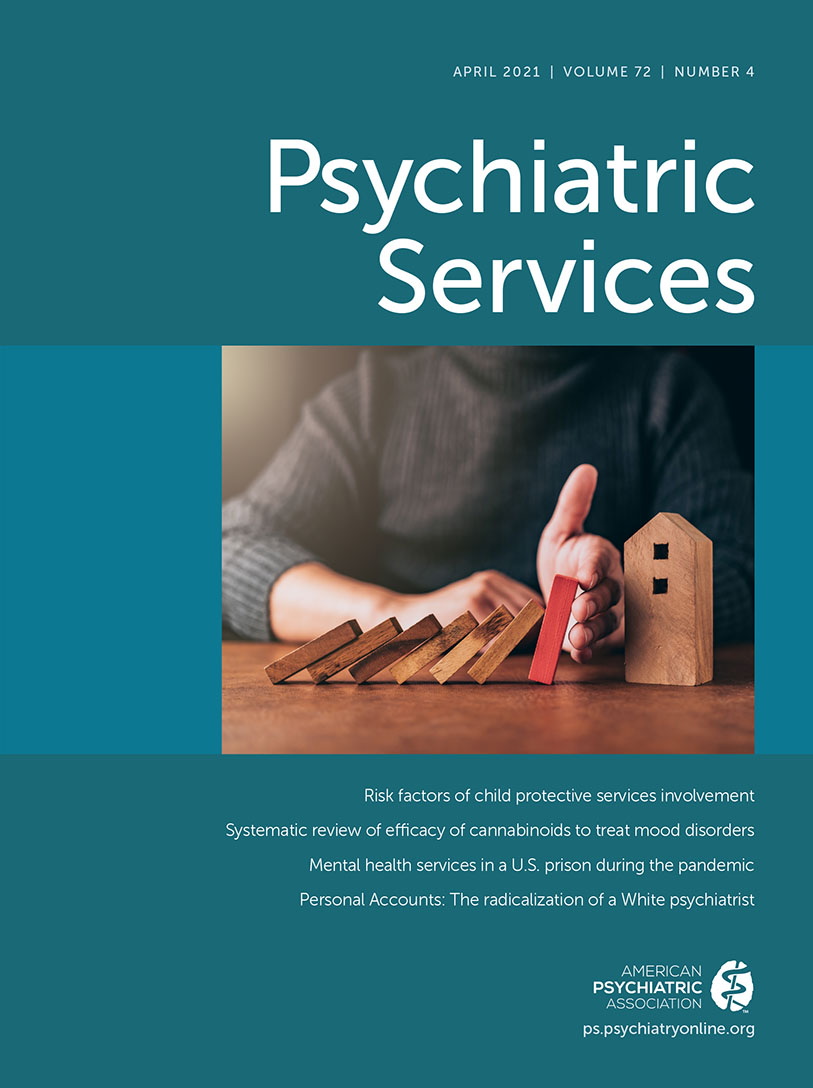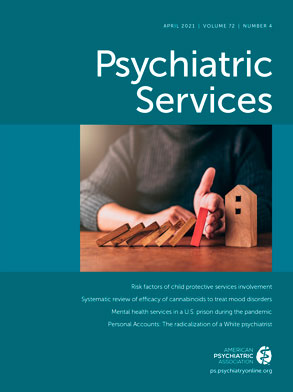In addition to having the same protections from disability-related discrimination provided to all U.S. citizens, incarcerated individuals have a constitutional right to medical care not afforded to the general public. The constitutional right to care covers serious medical needs, and recent court rulings have gone so far as to mandate use of a specific medication to treat a particular medical diagnosis. Clozapine is the only medication indicated for treatment-resistant schizophrenia (TRS). This column addresses whether withholding clozapine for this indication in jails and prisons constitutes a violation of patients’ legal rights.
Clozapine for TRS in Correctional Systems
The prevalence of serious mental illness in jails is estimated to be nearly four times higher than in the general population (
1), while the prevalence of schizophrenia in prisons ranges from 2.0% to 6.5% (
2). At year-end 2018, over 2 million U.S. residents were under the custody of state (N=1.29 million) or federal (N=179,000) prisons and local jails (N=738,000) (
3). However, this population is not static. In 2018, over 600,000 people were admitted and released from federal and state prisons, whereas almost 11 million people were incarcerated at some point in local jails. Given that in up to 30% of people with schizophrenia, the disorder is resistant to treatment (
4), tens of thousands of people with TRS, or more, were likely held in the U.S. correctional system at some time during 2018. Furthermore, incarcerated individuals with schizophrenia have a sevenfold higher risk of suicide compared with prisoners without schizophrenia (
5). Many more experience suicidal ideation or attempt suicide each year, although data regarding the incidence of these phenomena are more limited.
Despite its unique benefits and availability in generic form at low cost, clozapine is underused in the community because of its requirement for ongoing blood monitoring related to neutropenia, a more time-intensive initiation process compared with other antipsychotics, and providers who may not feel comfortable starting this medication or maintaining its use throughout treatment. Providers may also be concerned about serious side effects, such as myocarditis, seizures, cardiomyopathy, and high metabolic risk. Because of these barriers, TRS patients are far more likely to be prescribed two nonclozapine antipsychotics concurrently—a practice with limited supporting evidence—than to receive clozapine.
In state prisons, clozapine is underused and may not be available at all. A recent survey of prisons, to which 21 states responded, found that one-third did not have clozapine available on their formularies (
6). Clozapine prescribing is typically within the purview of psychiatry, and many systems face shortages of psychiatrists or may depend on contract services or part-time employees who may not be accustomed to initiating clozapine, contributing to its underuse. States in which clozapine was available treated a median of only eight individuals per state (
6).
In prisons, the harm of inadequately treating patients with psychotic symptoms is likely more severe than in community settings. Psychotic individuals can have difficulty following routine rules or instructions and are at higher risk of aggressive behavior toward themselves or others, often resulting in disciplinary infractions. For example, an individual with paranoia may not come out of his or her cell when asked or could react aggressively toward custody staff because of his or her hallucinations. In prisons, restrictive housing (also known as segregation or solitary confinement) is often used in response to disciplinary infractions and aggressive or otherwise disruptive behavior. Restrictive housing itself has been associated with worsening psychotic symptoms, self-injury, suicide attempts, aggression, and general psychological distress (
7). Individuals with severe mental illnesses such as TRS are more likely to be assigned time in solitary confinement, leading to undue suffering and higher costs to prisons (
8).
Furthermore, acutely psychotic prisoners frequently do not care for themselves and are prone to victimization at the hands of other inmates. Gangs are common in prisons and often prey on more vulnerable individuals. These issues generally go unnoticed or are ignored, leading some patients to suffer silently.
Clozapine As a Statutory and Constitutional Right
Correctional institutions that fail to offer clozapine to incarcerated persons with TRS are potentially vulnerable to two lines of legal assault. The first involves failure to protect incarcerated individuals with disabilities from discrimination, and the second involves violation of the Eighth Amendment protection against cruel and unusual punishment.
The Rehabilitation Act of 1973 and Title II of the Americans with Disabilities Act (ADA) are federal laws that protect individuals with disabilities from discrimination. In
Pennsylvania Department of Corrections v. Yeskey, the U.S. Supreme Court made clear that the rights afforded to persons with disabilities stemming from these laws apply to those incarcerated in jails and prisons (
9). All federal correctional facilities are covered by the Rehabilitation Act, whereas Title II of the ADA applies to jails and prisons operated by state and local governments. These laws define disability as a physical or mental impairment (such as a psychiatric disorder) that substantially limits one or more major life activities, including caring for oneself, concentrating, thinking, interacting with others, communicating, and working. There is no debate that individuals with TRS experience limitations to major life activities as a consequence of their illness and, therefore, that TRS fulfills the legal definition of a disability. Title II of the ADA indicates that “no qualified individual with a disability shall, by reason of such disability, be excluded from participation in or be denied the benefits of the services, programs, or activities of a public entity, or be subjected to discrimination by any such entity” (
10).
Incarcerated individuals with TRS can challenge a lack of access to clozapine by claiming that failure to make this medication available constitutes disparate treatment under the ADA. For individuals with a disability, correctional facilities may not provide an “aid, benefit, or service that is not as effective in affording equal opportunity to obtain the same result, to gain the same benefit, or to reach the same level of achievement as that provided to others” (
11). As noted above, although many people with schizophrenia respond well to nonclozapine antipsychotics, up to 30% do not, and clozapine remains the sole FDA-approved medication for these patients. As such, clozapine is the only therapy that will provide individuals with TRS the opportunity to obtain the same amount of relief from their psychiatric disability as patients who respond to first-line antipsychotics. By not offering clozapine therapy for this group, correctional institutions may be in violation of the ADA.
Furthermore, the ADA requires a public entity to “make reasonable modifications in policies, practices, or procedures when the modifications are necessary to avoid discrimination on the basis of disability, unless the public entity can demonstrate that making the modifications would fundamentally alter the nature of the service, program, or activity” (
12). Failing to make clozapine available and offering only first-line antipsychotics represents discrimination based on disability (namely, TRS). Correctional institutions may claim that providing clozapine and the requisite medical monitoring represents a fundamental change to the nature of services being offered at the facility. However, in our experience, multiple prisons within the North Carolina Department of Public Safety and some local jails have been able to accommodate clozapine therapy with minimal impact on overall programming and services. Thus, the “fundamental alteration” defense is not likely to be effective for correctional institutions.
The second line of legal attack relates to the constitutional right of incarcerated persons to treatment. In its landmark decision in
Estelle v. Gamble, the U.S. Supreme Court held that correctional officials who demonstrate deliberate indifference to an incarcerated person’s serious medical needs are in violation of the Eighth Amendment’s protection against cruel and unusual punishment (
13). The rule established by
Estelle v. Gamble covers all medical conditions, including psychiatric illnesses, and applies to sentenced inmates and pretrial detainees alike (via the due process clause of the Fourteenth Amendment). Deliberate indifference has been equated with subjective recklessness as it is used in criminal law and thus falls between negligence and intent to harm. A correctional official shows deliberate indifference if he or she is aware of a substantial risk to an incarcerated person’s health and disregards that risk.
On the basis of analogous arguments, jails and prisons have been mandated to provide treatment for conditions ranging from hepatitis C infection to opioid use disorder. In the case of hepatitis C, Dore and Trooskin (
14) noted that hundreds of lawsuits have been filed regarding the need to offer newly available and highly effective direct-acting antiviral therapy to incarcerated patients. Their analysis shows that courts have not been in full alignment regarding how far prisons must go to provide care and whether it is constitutional to ration this costly treatment on the basis of severity of disease. However, some state prisons are moving forward with innovative plans to offer hepatitis C treatment (
14).
With respect to opioid use disorder, courts have gone so far as to mandate treatment with a specific medication. Since 2018, plaintiffs have successfully challenged the denial of opioid agonist therapy within jails and prisons, with court rulings in Massachusetts (
Pesce v. Coppinger), Maine (
Smith v. Aroostook County), and Washington (
Kortlever v. Whatcom County) supporting a right to treatment with methadone or buprenorphine during incarceration (
15). Notably, the courts provided injunctive relief mandating that methadone or buprenorphine be administered to the inmate-plaintiffs, despite availability of another medication (naltrexone) approved by the U.S. Food and Drug Administration, because opioid agonist therapy has more supporting evidence than any other treatment modality for management of opioid use disorder. These decisions have relevance to clozapine in corrections because clozapine has been shown to be the most effective antipsychotic medication for TRS. Also of note, buprenorphine is a controlled substance with abuse potential, and hepatitis C drugs remain costly, while neither is the case with clozapine for TRS.
A case currently before the U.S. District Court for the Eastern District of Wisconsin has raised the issue of a right to clozapine treatment during incarceration (
16). The plaintiff, a prisoner, filed a lawsuit against the Milwaukee County Sheriff’s Office and correctional officials associated with the Milwaukee Criminal Justice Facility claiming that his federal statutory and constitutional rights were violated when his clozapine was not continued during incarceration. Specifically mentioned in the claims are the Rehabilitation Act of 1973, the ADA, and the Eighth and Fourteenth Amendment protections discussed above. The plaintiff was placed in solitary confinement, which the lawsuit asserts was because of symptoms of his inadequately treated psychotic illness. The court has yet to issue a ruling, but a judgment favorable to the plaintiff in this case could serve as a warning to jails and prisons that failure to offer clozapine may expose them to the risk of successful inmate litigation.
TRS is associated with undue suffering in the form of severe and persistent psychotic symptoms, victimization, and aggression toward oneself and others. Incarcerated individuals with TRS are at higher risk of being placed in solitary confinement (
8), often worsening their symptoms. It should be evident to correctional behavioral health clinicians which individuals in a correctional facility have TRS, given the generally accepted criteria of having failed two adequate trials of nonclozapine antipsychotics with ongoing psychosis and significant functional impairment. Thus, officials cannot argue that they lacked knowledge of who was classified as having TRS. Because the significant risks to health and well-being associated with TRS are well established, and because of the immediate identifiable harm patients with untreated or undertreated TRS face in correctional systems, failure to offer the only FDA-approved therapy for this condition may constitute an Eighth Amendment violation.

